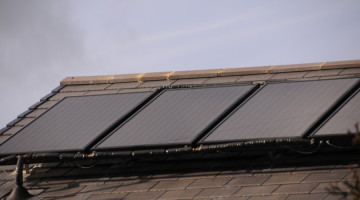
The Renewable Heat Incentive
The Renewable Heat Incentive, or RHI, was announced in 2008 as part of the Energy Act, although it didn’t come in to effect until 2014. It’s a government subsidy designed to reward smallscale renewable heating systems across England, Scotland and Wales. There’s a commercial arm to it as well, but we’re drilling down on the Domestic RHI in this article.
Solar Thermal
Solar thermal (also known as solar heating) harnesses the energy provided by the sun to provide thermal energy to heat water. Unlike a solar photovoltaic cell array, which is designed to produce electricity, a solar heating system is designed simply to produce heat. You can find out more here.
Step One: Estimated Annual Generation
Unlike for heat pumps and biomass boilers, your payments for solar thermal don’t use your EPC heat demand as part of the calculation. (Despite that, you’ll still need an EPC certificate issued within the last 2 years to qualify so make sure you have that paperwork anyway.) Instead, your solar thermal works on the basis of the estimated annual generation.
The estimated annual generation is a number provided in the MCS certificate issued by your MCS installer. You can get a decent idea of what this will be using the official RHI calculator here. It will give you a good estimate, but nothing is certain until the MCS certificate is issued.
Since 2017 the annual heat demand for RHI heat pumps and biomass boilers has been capped, but solar thermal has no upper limit.
Step Two: RHI Tariff Rate
The Renewable Heat Incentive tariffs are not permanently fixed, but rather they are review every 6 months by the Department for Business, Energy & Industrial Strategy (BEIS). This can lead to adjustments, known as degression. Theoretically, degression can alter the tariff by up to 20% in one swift move. There may also be adjustments in line with the Consumer Price Index (CPI), designed to allow for national inflation. However, since the rates were raised at the beginning of 2018 (following the implementation of a heat demand limit), there’s been very little change.
Your payments will be set at the tariff rate that was applicable on the date of your application.
The rates we’re using here are the Renewable Heat Incentive tariff rates, accurate of April 2019.
Step Three: Calculating Quartlery, Annual, and Total Repayments
So, now that we have all the numbers we need, it’s pretty simple to figure out the payments we can expect.
First we have to divide the tariff rate by 100 to get it into a standard currency format, as opposed to pence. So the solar thermal rate of 21.09p tariff rate becomes £0.2109.
Annual Payments:
Multiply the above standard format tariff rate by the number on your MCS certificate. Simple!
Quarterly Payments:
Divide your annual payments by 4.
Total RHI Payments:
Multiply your annual payments by 7.
We’ve put some examples below of how different heat demands create:
| Building | Final Applicable Heat Demand | Quarterly Payment | Annual Payment | Total RHI Payback |
| Small house, good insulation | 1,000 | £52.73 | £210.90 | £1,476.30 |
| Medium house, average insulation | 1,500 | £79.09 | £316.35 | £2,214.45 |
| Large house, poor insulation | 2,500 | £131.81 | £527.25 | £3,690.75 |
Think we missed something? Do you have a different opinion?
Comment below to get your voice heard…












No Comments yet! Be the first one.